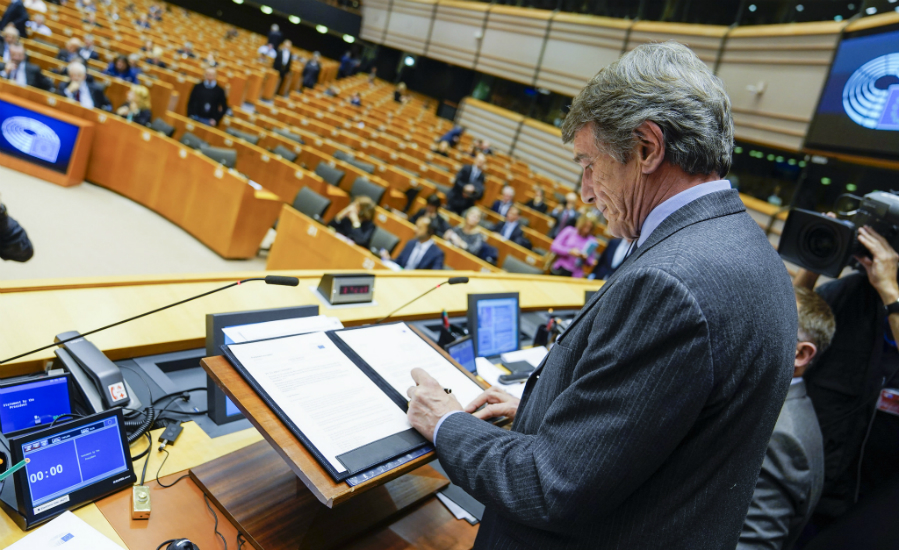Brexit Endgame: Britain’s EU Departure Marks the End of Brexit’s Beginning
After months of uncertainty, Britain is finally leaving the European Union.

Published by The Lawfare Institute
in Cooperation With

Editor’s Note: This article originally appeared on Order from Chaos.
Brexit Day—January 31, 2020—has finally arrived. Forty-seven years after the United Kingdom joined the European Economic Community. Three years and 7 months after the British electorate voted in a referendum called by then-Prime Minister David Cameron to leave the European Union. Fourteen months after former Prime Minister Theresa May reached an initial divorce settlement with the EU (and this blog series was born). Three months after her successor, Boris Johnson, renegotiated the deal and six weeks after he won a sufficient parliamentary majority to ensure its ratification.
After campaigning on a slogan of “Get Brexit Done,” Johnson is now keen to focus public attention on domestic issues and has reportedly instructed officials to drop the term “Brexit” after January 31. Yet this date only marks the end of the first phase, the divorce. The harder discussion about the future U.K.-EU relationship lies ahead, set against the backdrop of a polarized electorate and uncertainty about the country’s constitutional unity.
Did the Brexit Bill Face Any Final Obstacles?
The newly elected House of Commons backed the Withdrawal Agreement Bill on January 11. The House of Lords—where Johnson does not have a majority—dealt the government its first legislative defeat by backing five amendments on January 21. One cited the Sewel Convention, which holds that Parliament will not “normally” legislate on devolved issues without the consent of the devolved institutions. Notably, all three legislatures—in Cardiff, Edinburgh, and Belfast—rejected the bill. Although this convention is not legally binding, the government’s dismissal of their concerns could create a political backlash. The next day, the Conservative-dominated Commons decisively rejected all changes. When the bill returned to the Lords, peers backed down and adopted the final text. The bill received royal assent on January 23.
How Did the EU Finalize the Deal?
On January 24, European Commission President Ursula von der Leyen and European Council President Charles Michel signed the Brexit agreement. Michel tweeted: “Things will inevitably change but our friendship will remain. We start a new chapter as partners and allies.” The European Parliament’s Constitutional Affairs Committee approved the deal on January 23. The full parliament completed the process with a 621-49 vote during an emotional plenary session on January 29. Nigel Farage—a British member of the European Parliament (MEP) for 20 years and leading campaigner for Brexit—made his final speech, lambasting the EU while his Brexit Party colleagues waved Union Jack flags. After the vote, MEPs serenaded their British counterparts with Auld Lang Syne.
How Is Brexit Day Being Commemorated?
On January 31, Johnson and his cabinet will hold a rare meeting in northern England to discuss the government’s plans to promote economic prosperity across the country. Politically, it gives a nod to long-time Labour supporters in the region who backed the Conservatives in the December election.
That evening, Johnson will deliver a televised address from his office. A countdown clock to 11pm London time will be projected onto Downing Street, while the streets of Whitehall will be filled with Union Jack flags and illuminated government buildings. Farage will host his own celebrations in Parliament Square, including patriotic songs and flag-waving. Brexiteers wanted Big Ben—the iconic clock on the Houses of Parliament—to ring at the moment of Britain’s departure; given ongoing restoration work, the cost of temporarily returning the clapper to the clock was deemed prohibitively expensive. The government produced commemorative 50 pence coins, which bear the inscription “Peace, prosperity and friendship with all nations” and the January 31 date.
In Brussels, the mood will be subdued. After midnight, British access to EU infrastructure will end and maintenance workers will quietly remove British flags from EU buildings. The three EU presidents (Michel, Sassoli, and von der Leyen) will issue a joint statement. They will also hold discussions about the future of Europe, meeting at the former home of French statesman Jean Monnet—one of the architects of the original institution that evolved into the European Union. They will then visit Albania and North Macedonia, which are both seeking to join the EU.
What Are the Major Challenges Ahead?
EU Trade Talks
As outlined in a previous blog post, the U.K. now begins an 11-month transition period. Although it will leave the EU’s decisionmaking institutions, it will remain bound by the bloc’s rules and enjoy its benefits for the remainder of 2020. Citizens and businesses must begin adjusting to post-Brexit realities (see a video of Johnson answering some frequently asked questions).
Leaders will focus on determining the future EU-U.K. economic relationship, with talks expected to begin in early March after both sides decide their negotiating objectives. The British government wants a loose deal focused on zero tariffs and zero quotas; the EU will insist on a level playing field, including social and environmental standards, state aid, and tax. It will be virtually impossible to reach—and ratify—a comprehensive agreement within the short timeframe. This suggests three possible outcomes: 1) the sides reach a limited agreement focused on goods, with remaining issues to be addressed later; 2) Johnson asks the EU to extend the transition period before the July 1 deadline, despite his current aversion; or 3) the U.K. leaves the EU on December 31 without a deal and defaults to World Trade Organization (WTO) trade terms.
U.S. Trade Talks
At the same time, the U.K. is expected to begin trade talks with the United States. The Conservative Party’s election manifesto aimed “to have 80 per cent of U.K. trade covered by free trade agreements within the next three years, starting with the USA, Australia, New Zealand and Japan. These will be negotiated in parallel with our EU deal.” However, Chancellor Sajid Javid made clear at Davos that Europe was the priority. This is a sensible approach, given the limited timeframe and primacy of that trading relationship. Although Brexit gives the U.K. the freedom to deviate from EU regulations, the government needs to decide whether and when to do so. Javid alarmed British businesses in mid-January by warning that “there will not be alignment,” with the EU and insisting firms must “adjust” to new regulations. He backtracked a week later at Davos, reassuring companies that the U.K. would only diverge when it was in the business interest and not “for the sake of it.”
U.S. Treasury Secretary Steve Mnuchin was disappointed to be placed on the backburner, noting at Davos that he “thought we’d go first… [The EU] may be a little harder to deal with than us anyway.” When the officials later met in London, Mnuchin stressed the U.S. was “prepared to dedicate a lot of resources” to securing a deal this year and “optimistic” the British government could handle both discussions. The Trump administration wants a quick win in an election year, while the Johnson government wants a rapid demonstration of Brexit’s financial benefits. Yet London faces controversial demands from Washington on issues like pharmaceutical pricing, food standards, and the environment. Trade tensions are already looming, as Mnuchin threatened tariffs on British carmakers after Javid refused to cancel a 2 percent digital tax on big tech firms.
More broadly, the U.K. could find itself squeezed between Europe and the United States as it navigates post-Brexit economic and foreign policies. Although Johnson wants to remain on Trump’s good side in trade talks, he remains more closely aligned with the EU on issues such as Iran, climate change, and digital tax. This week, Johnson’s government agreed—despite sustained American lobbying—to allow the Chinese tech firm Huawei to build part of Britain’s 5G network. This decision could affect U.S. intelligence sharing and complicate congressional ratification of a trade deal. Yet the British government seems unconcerned, with one official explaining: “In 10 years, we want to be a high-tech Silicon Valley across the whole of the U.K. That is more important than getting slightly cheaper meat.”
Northern Ireland
The biggest challenge in reaching a Brexit deal concerned the handling of Northern Ireland. The compromise removed the unpopular backstop and replaced it with a protocol, which said Northern Ireland would follow EU rules on agricultural and manufactured goods as well as enforce EU customs rules at its ports. In order to avoid infrastructure on the Irish land border, there must be checks on goods moving between Northern Ireland and Great Britain. They would be minimized if the U.K. followed EU regulations, but Johnson has heralded deviation as a benefit of Brexit. Differentiation could create long-term challenges—both economically and politically—for Northern Ireland, including looming questions about potential Irish unification.
On the eve of Brexit, the issue remains contentious. Johnson claimed “emphatically” that “unfettered access” for Northern Irish businesses to Great Britain’s market would also apply in the other direction, suggesting there would not be checks on goods crossing the Irish Sea. Yet the EU’s Brexit negotiator, Michel Barnier, strongly disagreed, warning the protocol “makes frictionless trade impossible” and “makes checks indispensable.”
Scotland
Despite Johnson’s pledge to unify the country, tensions will remain between Edinburgh and London. The Scottish National Party (SNP) heads a minority government in Scotland, and it won 48 of 59 Westminster seats in the December elections. Johnson rebuffed a request in mid-January from Scottish First Minister Nicola Sturgeon for a second independence referendum; he argued the 2014 poll was a “once in a generation” event, while she cited the “material change in circumstances” since then. He also ignored the Scottish Parliament’s rejection of his Brexit deal, which will heighten calls for a Scottish role in scrutinizing trade deals that affect policies that were devolved to Scotland before Brexit (such as fisheries, agriculture, and environment).
On January 29, the Scottish Parliament backed calls for a second independence referendum in a 64-54 vote on a non-binding motion. Sturgeon’s government wants a poll later this year. The Parliament also voted to keep the EU flag flying over its building after Brexit. Sturgeon will mark Brexit Day by delivering a speech on the “next steps in the campaign to secure Scotland’s future as an independent nation.” Polling data shows a slight increase in support among Scottish voters for independence, though it generally remains short of a majority.
Any Parting Words?
This blog series, which was envisioned as a four-month tracker of Brexit’s final phase, evolved into a 14-month labor of love that was born from lived experience in Edinburgh, Belfast, and Brussels. Although this piece marks the end of the “Brexit endgame” series, Brexit itself is far from over.
British officials must now begin the hard work of renegotiating existing relationships, managing deep internal divisions (within the electorate as well as between the country’s constituent parts), and finding a role in a world that has changed significantly since the U.K. joined the European Economic Community in 1973. Underscoring the complexity of this task, there are now 25,000 British civil servants working on Brexit—a three-fold increase since 2018. This inward focus will inevitably limit the government’s bandwidth for dealing with broader domestic and international challenges. It will become clear in time if Brexit heralds a “Global Britain” that flourishes economically outside EU regulatory constraints and strikes advantageous trade deals with countries like the United States, or if it results in an economically weakened and internationally isolated middling country that is plagued by domestic tensions.
Reflecting the views of many sad Europeans on this occasion, European Parliament President David Sassoli concluded: “Dear British friends, in Italian addio is too definitive a word, which is why together with all my colleagues I say only arrivederci. I want to leave you with the words of Jo Cox, the UK MP killed during the referendum campaign: ‘We are far more united and have far more in common with each other than things that divide us.’”





